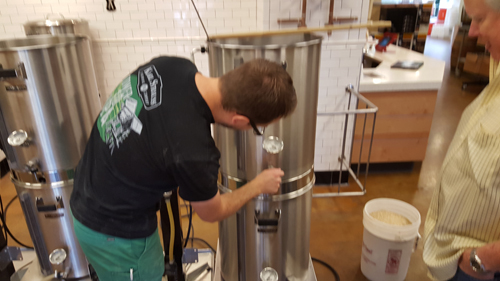The brewing session began at 10:30 a.m. and ended by 2:00 p.m. with time in the middle for lunch. They offer beer for sampling right there.
The following is an essay in photos. I'll keep words to a minimum and only to clarify best as I can recall. I did ask quite a lot of questions, the answers being technical went schwing right over my head. But I do think that I have a much better understanding of how beer is made, a better handle on their contrived vocabulary. Like wort, and pitching and specific gravity, conditioning, and Gruit.
It was fun! More fun than imagined. More fun than a barrel of beer monkeys.
75 photos follow
The selection of grains is bewildering. Choosing might be the most difficult part.
Stick with your initial instincts and go for it. Or else you'll be there all week and then ruminate your decision.
The grain is milled to smaller chunks but not so fine to powder as flour. Nevertheless, it would be a great place to buy grain for bread.
Two types of grain are mixed in the mill for the type beer selected today.
It's impressive how confident this young man is in what he does. Everything is measured scientifically. He's very good with his cellphone as well.
The top and the bottom halves of the stacked containers both hold 20 gallons. This round is producing 10 gallons of beer so the top container fills only half way.
That made me wish I had purchased 20 gallons to see the thing filled to the top. I was told right then by both facilitator and guest the beer loses flavor over time. Noticeably within six months. It will not store that long. So 10 gallons was the best choice after all.
The water and grain percolates stripping the grain of 70% of its sugar. It is taste-tested before the hops are added. I found it pleasant. Like grain tea. Very nice. I'd be satisfied to stop right here. The temperature is some 50˚ below boiling, I think, so that the proteins are not denatured.
I asked but I did not comprehend the answer. "So that the sugars are available for the yeast to comsume." I accepted that answer. However, it IS all boiled later when hops are added and cooled down mechanically before the yeast is dumped in. So there you go, a bit of an unresolved contradiction. I'm sure there's an answer for this that I did not understand.
Percolating ends. All the beer is drained to the bottom. The heat raised to boiling for the addition of hops.
These hops are compressed into pellets. They are added in increments as the beer is boiled to layer the flavor adding complexity. Oils are extracted. Further, there are two types of these hops pellets. They soak in a large steeping teabag. This is what balances the beer between sweet and bitter flavors.
Lunch. Yay! As the boiling of hops continues. The place has magazines to read and shelves with toys. But we were well pleased with conversing. The time goes by rather fast.
Boiling and layering hops incrementally finishes. New hoses are connected to cool the liquid quickly for the addition of yeast.
Containers are disinfected leaving disinfectant foam that is not rinsed out. Reason given, the rinse water risks recontamination. A bit disconcerting seeing the foam pushed out.
Oxygen for the yeast. And this whole time I thought yeast was anaerobic. Apparently it is not.
Second bucket yeast pitch. How 'bout that eh? I'm getting the lingo.
Maybe this is for a specific gravity test. And maybe he's just cleaning out his instrument.
The beer ferments in cool storage for two weeks and then it is bottled. We'll return to do that. The guest must design his own label and contrive a name for his beer.
I can tell you this tastes very good already. It's all made of real ingredients, no extracts, no concentrations or oils. This here is the real deal. And I have full faith the result will be outstanding. This whole project was just really very fun.
Recommended.
The idea here, I suppose, is to get you hooked on the joy of making your own beer at your home, now that you know how it's professionally done. The store is exceedingly well stocked. The best that I've seen in this town with a wide variety of all the ingredients of any type of approach. The whole operation is quite extraordinary.
Here's what the operation looks like inside.































































2 comments:
Braukunst
How cool is that! What a fun gift. I wish they would hold a class or something in our area on wine making and beer making. There are a couple of people that I know who do brew their own beers. Maybe we could press gang them into holding a seminar.
I've been told that cherry wine is delicious and in a few years we may (hope to) have a bumper crop of cherries since we planted 3 Black Tartans a few years ago and two Montmorcey (pie cherries) as cross pollinators.
Post a Comment